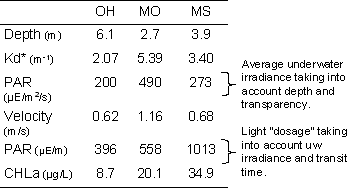

| Research
James River
Ecosystem Study ||
Restoration of Kimages Creek A Tale of Three Rivers Spatially extensive studies of large rivers are rare and comparative studies of multiple rivers even more so. Through funding from the EPA I had the opportunity to participate in a large-scale comparative study of the three largest US rivers. At first glance, the Ohio, Upper Mississippi and Missouri Rivers appear relatively similar being lowland rivers draining predominantly agricultural watersheds in the Central US. They differ in the extent to which their flow regime has been modified in that the Ohio and Upper Mississippi are regulated by low dams (for navigation) whereas the Missouri has high dams which create large impoundments. For our surveys of the chemistry and biology of these rivers we excluded the impoundments of the Missouri and sampled the free-flowing sections only. As for other EPA EMAP (Environmental Monitoring and Assessment Program) efforts, the sampling locations were selected at random so that results could be extrapolated to river-wide estimates. Over 500 sites were sampled during the 3-year effort corresponding to one site every 15 km over their entire length. A wide range of parameters were measured including water and sediment chemistry as well as macroinvertebrate and fish communities. My component of the project focused on plankton and geochemistry and was carried out in collaboration with Anthony Aufdenkampe (Stroud), John Chick (Illinois Natural History Survey), John Havel (Missouri State) and Jeff Jack (Louisville). I was surprised to find that the rivers exhibited large and consistent differences in phytoplankton abundance (measured as chlorophyll a). River-wide average CHLa concentrations were 5-fold higher in the Upper Mississippi (32 µg L-1) relative to the Ohio (7 µg L-1); the Missouri was intermediate (20 µg L-1). Given the spatially-extensive data and the probability-based sampling design, demonstrating that the 3 rivers differed with respect to primary production was straightforward but establishing why they differed proved more complicated. Nutrients and light availability regulate phytoplankton growth while grazing and sedimentation contribute to mortality. In rivers, velocity can also play a role in influencing abundance by determining the residence time of phytoplankton in the river. Light and nutrient conditions were found to be surprisingly variable both within and among rivers. Overall, the Upper Mississippi had the highest concentrations of both N and P and the most favorable light conditions based on underwater irradiance and transit time (see Table below). The Ohio by comparison was relatively nutrient poor and its deep channel resulted in low average irradiance in the water column. Our findings suggest that these rivers are sensitive to nutrient inputs despite generally poor light conditions. Mixing patterns and channel geomorphometry in part determines light conditions as phytoplankton may experience a transient release from light limitation during periods when they are closer to the water’s surface.
Further Reading Bergfeld, T., A. Scherwass, B. Ackermann, H. Arndt, and A. Schol 2009. Comparison of the components of the planktonic food web in three large rivers (Rhine, Moselle and Saar). River Research and Applications 25: 1232-1250. Bolgrien, D. W., T. Angradi, E. W. Schweiger, and J. R. Kelly 2005. Contemplating the assessment of great river ecosystems. Environmental Monitoring and Assessment 103: 5-20. Bukaveckas, P.A. 2009. Rivers. In: Gene E. Likens, (Editor) Encyclopedia of Inland Waters. Volume 1, pp. 721-732 Oxford: Elsevier. Delong, M. D., and J. H. Thorp 2006. Significance of instream autotrophs in trophic dynamics of the Upper Mississippi River. Oecologia 147: 76-85. Sellers, T., and P. A. Bukaveckas 2003. Phytoplankton production in a large, regulated river: A modeling and mass balance assessment. Limnology and Oceanography 48: 1476-1487. |
